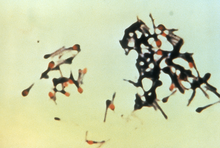Pathogenic bacteria
| Bacterial infection | |
|---|---|
| Classification and external resources | |
| MeSH | D001424 |
Although most of bacteria are harmless or beneficial, quite a few bacteria are deadly/pathogenic. One of the bacterial diseases with highest disease burden is tuberculosis, caused by the bacterium Mycobacterium tuberculosis, which kills about 2 million people a year, mostly in sub-Saharan Africa. Pathogenic bacteria contribute to other globally important diseases, such as pneumonia, which can be caused by bacteria such as Streptococcus and Pseudomonas, and foodborne illnesses, which can be caused by bacteria such as Shigella, Campylobacter, and Salmonella. Pathogenic bacteria also cause infections such as tetanus, typhoid fever, diphtheria, syphilis, and leprosy.
Koch's postulates are criteria designed to establish a causal relationship between a causative microbe and a disease.
Contents |
Diseases
Each pathogenic species has a characteristic spectrum of interactions with its human hosts.Conditionally pathogenic
Conditionally pathogenic bacteria are only pathogenic under certain conditions, such as a wound that allows for entry into the blood, or a decrease in immune function.For example, Staphylococcus or Streptococcus are also part of the normal human flora and usually exist on the skin or in the nose without causing disease, but can potentially cause skin infections, pneumonia, meningitis, and even overwhelming sepsis, a systemic inflammatory response producing shock, massive vasodilation and death.[1]
Some species of bacteria, such as Pseudomonas aeruginosa, Burkholderia cenocepacia, and Mycobacterium avium, are opportunistic pathogens and cause disease mainly in people suffering from immunosuppression or cystic fibrosis.[2][3]
Intracellular
Other organisms invariably cause disease in humans, such as obligate intracellular parasites (e.g. Chlamydophila, Ehrlichia, Rickettsia) that are able to grow and reproduce only within the cells of other organisms. Still, infections with intracellular bacteria may be asymptomatic, such as during the incubation period. An example of intracellular bacteria is Rickettsia. One species of Rickettsia causes typhus, while another causes Rocky Mountain spotted fever.Chlamydia, another phylum of obligate intracellular parasites, contains species that can cause pneumonia or urinary tract infection and may be involved in coronary heart disease.[4]
Salmonella, Neisseria, Brucella, Mycobacterium, Listeria, Francisella, Legionella, and Yersinia pestis can exist intracellularly, though they are facultative (not obligate) intracellular parasites.
By location
Following is a list of bacterial infections classified by location in the body:- Bacterial vaginosis is a disease of the vagina caused by an imbalance of naturally occurring bacterial flora and is often confused with yeast infection (candidiasis), or infection with Trichomonas vaginalis (trichomoniasis), which are not caused by bacteria.[5][6]
- Bacterial meningitis is a bacterial inflammation of the meninges, that is, the protective membranes covering the brain and spinal cord.
- Bacterial pneumonia is a bacterial infection of the lungs.
- Urinary tract infection is almost exclusively caused by bacteria. Symptoms include frequent feeling and/or need to urinate, pain during urination, and cloudy urine.[7] The main causal agent is Escherichia coli. Although urine contains a variety of fluids, salts, and waste products, it does not usually have bacteria in it,[8] but when bacteria get into the bladder or kidney and multiply in the urine, they may cause a UTI.
- Bacterial gastroenteritis is caused by pathogenic enteric bacteria. Such pathogenic enteric bacteria are generally distinguished from the usually harmless bacteria of the normal gut flora, but the distinction is often not fully clear, and Escherichia, for example, can belong to either group.
- Bacterial skin infections include:
- Impetigo is a highly contagious bacterial skin infection most common among pre-school children.[9] It is primarily caused by Staphylococcus aureus, and sometimes by Streptococcus pyogenes.[10]
- Erysipelas is an acute streptococcus bacterial infection[11] of the deep epidermis with lymphatic spread.
- Cellulitis is a diffuse inflammation[12] of connective tissue with severe inflammation of dermal and subcutaneous layers of the skin. Cellulitis can be caused by normal skin flora or by exogenous bacteria, and often occurs where the skin has previously been broken: cracks in the skin, cuts, blisters, burns, insect bites, surgical wounds, intravenous drug injection, or sites of intravenous catheter insertion. Skin on the face or lower legs is most commonly affected by this infection, though cellulitis can occur on any part of the body.
Treatment
Main article: Antibiotics
- See also overview list below


No comments:
Post a Comment